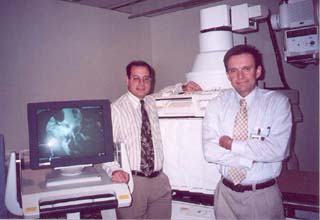
Patients in need of digital fluoroscopy services now have to travel no further than Lakeside Health System. New equipment has been purchased, renovations have been completed for the installation of the fluoroscopic equipment and patients are reaping the rewards of the new technologies. "We are examining about five to six patients a day, but as we progress, those numbers will surely go up," Chief Radiology Technologist Michael Heary said. "Also, with this new equipment, the hospital will be able to begin offering angiography services." Angiography x-rays, Heary explained, allows for the digital imaging of a patient's arteries so the technologists can determine where, if any, obstructions are occurring. "This will be a brand new service and one from which the patients will greatly benefit." Digital fluoroscopic procedures, Chief of Radiology Dr. Michael Chess said, offer patients a convenient, safe and top quality procedure. "Digital fluoroscopy examinations have been benefits. Digital exams require a lower radiation dosage than traditional fluoroscopic exams which means added patient safety," he explained. "Digital exams are also faster and result in higher quality images." Heary agreed, saying that the digital fluoroscope offers patients half the radiation and images that are 100 percent better in quality. "Rather than having to wait for the film to be developed, we can tell instantly whether we have received a good image and if we happen to see an ulcer, or other abnormality, we can look at it immediately," Dr. Chess said. Conventional uses of fluoroscopy are applications which involve ascertaining the placement of needles and catheters or studies that involve viewing motion in real time, such as swallow studies which are becoming more prevalent in an aging population. New uses for fluoroscopy have included interventional work such as esophageal stricture dilation using balloons. Gastroenterologists have also made use of fluoroscopy in performing examinations viewing the gallbladder, pancreas and related ducts. Fluoroscopy allows the physician to remain by the patient's side to provide comfort and explanation, something which is not possible with more complex imaging procedures like an MRI or CT scan. "This equipment allows us to offer referring physicians information that gives them live, moving images in real time," Heary said. "With traditional equipment we offer a snapshot of a minute in time." The images are transmitted from the digital fluoroscopic machine to a computer work station where the images are stored. Referring physicians have access to the images through a password which enables them to link to Lakeside's website. "A film can still be printed, but this process makes it quicker and easier for the physicians," Heary said. "The images can also be burned onto a CD and sent with a patient to their physician." Offering expanded services to both patients and clinicians is one of the main reasons the digital fluoroscopic equipment was made a part of Lakeside's health care service package. "We have made a lot of technological advances here in the past year," Dr. Chess said. "We are also on our way to becoming a film-less radiology department because the images will be stored on the computer and on CD's." Lakeside offers digital upper and lower GI procedures and a full spectrum of other radiology services including ultrasounds, mammography, MRI, CT and nuclear medicine. Call the Lakeside Radiology Department at 395-6041 for information. |
